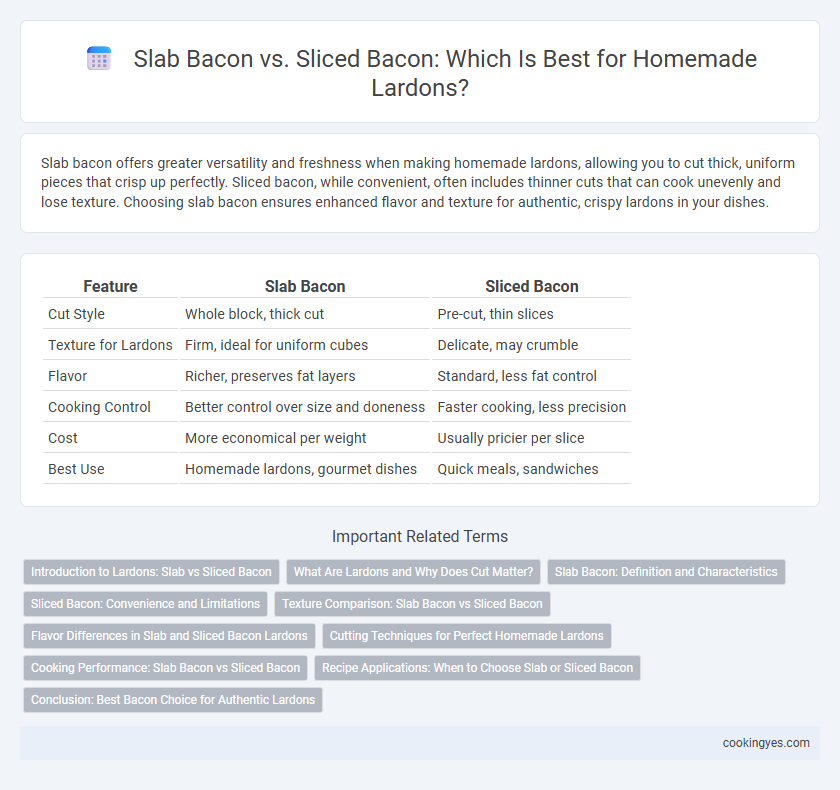Slab bacon offers greater versatility and freshness when making homemade lardons, allowing you to cut thick, uniform pieces that crisp up perfectly. Sliced bacon, while convenient, often includes thinner cuts that can cook unevenly and lose texture. Choosing slab bacon ensures enhanced flavor and texture for authentic, crispy lardons in your dishes.
Table of Comparison
| Feature | Slab Bacon | Sliced Bacon |
|---|---|---|
| Cut Style | Whole block, thick cut | Pre-cut, thin slices |
| Texture for Lardons | Firm, ideal for uniform cubes | Delicate, may crumble |
| Flavor | Richer, preserves fat layers | Standard, less fat control |
| Cooking Control | Better control over size and doneness | Faster cooking, less precision |
| Cost | More economical per weight | Usually pricier per slice |
| Best Use | Homemade lardons, gourmet dishes | Quick meals, sandwiches |
Introduction to Lardons: Slab vs Sliced Bacon
Slab bacon offers a thicker, uniform cut ideal for homemade lardons, providing better control over size and texture compared to pre-sliced bacon. Using slab bacon ensures each lardon maintains its shape during cooking, delivering consistent crispiness and rich flavor. Sliced bacon may cook unevenly and become overly thin, diminishing the authentic lardon experience essential in classic French dishes.
What Are Lardons and Why Does Cut Matter?
Lardons are small strips or cubes of pork fat or bacon used to add rich flavor and texture to dishes. Slab bacon is preferred for homemade lardons because it offers uniform thickness and easier control over the size, ensuring even cooking and crispy results. Sliced bacon often varies in thickness and is pre-cut, which can lead to uneven lardons and inconsistent texture in recipes.
Slab Bacon: Definition and Characteristics
Slab bacon is a whole, uncut piece of cured pork belly, allowing for thicker and more uniform slices ideal for homemade lardons. Its dense texture and higher fat content ensure a rich flavor and crispiness when cooked, enhancing dishes like salads and quiches. Unlike pre-sliced bacon, slab bacon offers greater control over slice thickness, essential for perfecting the size and texture of lardons.
Sliced Bacon: Convenience and Limitations
Sliced bacon offers convenience for homemade lardons due to its pre-cut uniform strips, saving preparation time and ensuring consistent cooking. However, the thinner slices can limit texture and crispiness compared to thicker slab bacon, potentially resulting in less substantial lardons. For recipes requiring a robust, chewy bite, slab bacon remains the superior choice despite the extra effort in slicing.
Texture Comparison: Slab Bacon vs Sliced Bacon
Slab bacon offers a thicker, more substantial texture that crisps up evenly when cut into homemade lardons, creating a satisfying crunch and rich mouthfeel. Sliced bacon, thinner and pre-cut, tends to cook more quickly but often results in a softer, less uniform texture in lardons. For optimal texture and caramelization in recipes requiring lardons, slab bacon provides superior control and a heartier bite.
Flavor Differences in Slab and Sliced Bacon Lardons
Slab bacon offers a richer, more pronounced smoky flavor and a firmer texture ideal for homemade lardons, allowing precise control over thickness and crispness during cooking. Sliced bacon, pre-cut and often thinner, tends to cook faster but may lack the depth of flavor and robust texture that slab bacon provides. Choosing slab bacon enhances the caramelization process, resulting in more intense, savory lardons perfect for salads, quiches, and gourmet dishes.
Cutting Techniques for Perfect Homemade Lardons
Slab bacon offers superior control for cutting perfect homemade lardons, allowing for uniform thickness and size consistency essential in recipes. Using a sharp chef's knife to slice perpendicular to the fat lines ensures even cooking and optimal texture. Sliced bacon limits customization, often resulting in uneven lardons that can cook unevenly and affect dish presentation.
Cooking Performance: Slab Bacon vs Sliced Bacon
Slab bacon offers superior cooking performance for homemade lardons, providing thicker, more uniform pieces that render fat evenly and develop a crisp texture without burning. Sliced bacon often contains pre-cooked edges and varying thickness, leading to uneven caramelization and less control during frying. Using slab bacon ensures better flavor extraction and crispness, crucial for authentic lardon preparation in dishes like quiche or salads.
Recipe Applications: When to Choose Slab or Sliced Bacon
Slab bacon offers greater flexibility for homemade lardons, allowing precise cutting into uniform cubes essential for even cooking and optimal texture in recipes like quiches or salads. Sliced bacon provides convenience for quick preparation but often results in thinner, less consistent lardons that may cook unevenly or crisp too quickly. Choosing slab bacon enhances recipe control and quality, especially when lardons need to retain a balance of chewiness and crispness in dishes.
Conclusion: Best Bacon Choice for Authentic Lardons
Slab bacon offers superior texture and flavor control for authentic homemade lardons due to its thickness and even fat distribution, which crisps perfectly when rendered. Sliced bacon, often pre-cooked or thinner, lacks the substantial mouthfeel and caramelization ideal for traditional lardon recipes. Choosing slab bacon ensures rich, crispy lardons with the genuine smoky and savory essence characteristic of classic French cooking.
Slab bacon vs sliced bacon for homemade lardons Infographic

 cookingyes.com
cookingyes.com